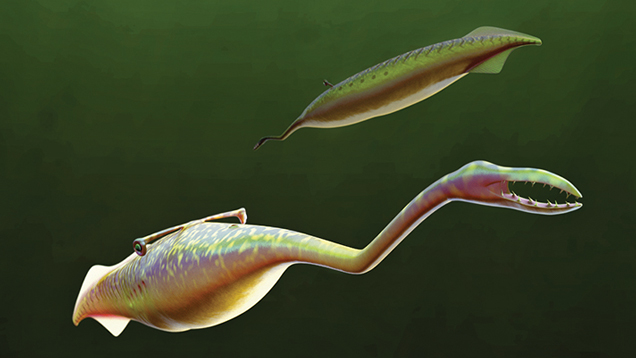Scientific Adventures: New info sheds light on the mysterious Tully Monster
 CREDIT: ILLUSTRATION BY SEAN MCMAHON / YALE UNIVERSITY
CREDIT: ILLUSTRATION BY SEAN MCMAHON / YALE UNIVERSITYThe Tully monster, pictured above, is theorized to have been an open ocean hunter, sometimes travelling to coastal areas.
This week we go back to the age of dinosaurs, with new information on fossils of a so-called monster and bird legs getting a little prehistoric.
Tully Monster is explained… sort of
In 1958, Francis Tully, an amateur paleontologist searching Illinois coal pits, found thousands of the same odd creature called Tullimonstrum gregarium but more commonly known as the Tully Monster. It has baffled scientists since it was found, with researchers not even sure what order of the Taxonomic tree it was supposed to inhabit, only knowing it was an animal of some sort.
What made understanding the creature even more challenging was that fossils of the Tully Monster, which date back 300 million years, are only found in Illinois.
Partnering with the Field Museum of Natural History, Argonne National Laboratory and the American Museum of Natural History, Yale researchers studied over 1,200 fossil specimens that were saved in concretions, helping to preserve large portions of the creatures’ soft tissues.
The team correlated anatomical data of structures found within the Tully Monster with morphological traits of animals currently known to try and make a classification.
As a Yale press release stated, concretions are masses of hard rock that formed around the Tully Monsters as they fossilized, making it possible to study the creature in such high detail.
The team used a synchrotron, which is a type of particle accelerator that generates powerful beams of electrons. When the path of electrons is bent by sets of magnets, synchrotron light is produced which is extremely bright.
The synchrotron light was used to study the chemistry of the fossils, buried within the layers of the rock and previously unobservable through any other means.
Data from the synchrotron revealed unknown biological structures within the fossils never before viewed in any of the thousands of specimens, including gills and a flexible cartilage rod known as a notochord.
Notochords are important biologically because they allow the animal to have a semi-rigid internal structure, allowing for muscle attachment.
Both the gills and notochord were crucial in determining what modern day species might be related to the ancient animal.
While previously thought to be a type of snail or sea worm, the paper concluded that the Tully Monster was in fact a vertebrate and an early ancestor of the lamprey.
The conclusion was due to the notochord, the position and number of fins, the presence of skull-like features called tectal cartilage, also found in lampreys, as well as several other morphological features the two shared.
Fun fact: the Tully Monster is Illinois’ official state fossil.
Growing dinosaur chickens
A team of Chilean scientists, building upon research published in 2015, have been able to cause multiple species of bird embryos to grow dinosaur-shaped legs.
While it’s well understood that avians evolved from tetanuran or ‘stiff-tailed’ dinosaurs, what isn’t fully understood is how and why the various morphological changes to body structure happened, transforming the velociraptor to your everyday chicken over time.
The study not only wanted to understand the intermediate evolutionary steps that took place in bird legs, but also at what phase of development the leg bones begin to lose their ancestral shape.
The scientists used genetic modifications to a specific gene, regulating how sections of the bone, called growth plates, grew.
Dinosaur legs had two bones, the outer fibula and the inner tibia, which worked together to support the body’s weight onto the foot, similar to human legs.
In birds, both bones are still present, but the fibula is much smaller than the tibia.
In fact, you can see this next time you eat chicken wings. The small shard that runs along the main bone of drumsticks is the fibula.
In addition to it being smaller, the fibula doesn’t connect to the heel bone in modern birds whereas in dinosaur legs it did.
In the study, the gene IHH was inactivated which, when activated, would cause the end of the fibula to stop growing. This inactivation of IHH led to the increase of a gene call PTHrP to be present at the end of the fibula, facilitating its growth into the dinosaur-like shape.
Using embryos from six different orders, the scientists determined the chicken tests to contain the closest bone formation and shape to that of dinosaur’s walking limbs.
The final results led the team to propose a new hypothesis of how the fibula began to shrink through the evolutionary timescale, stating that the proximity of the bones during specific growth phases was more important than when individual sections of the fibula stopped growing.
In late 2015, the same researchers were able to cause the feet of chicken embryos to form into prehistoric dinosaur feet through genetic modification as well. In early 2015, another team was able to cause the skulls of bird embryos to form into the shape of crocodilians, which are birds’ closest living dinosaur relative.
Next week we’ll take a look at how bacterial photosynthesis is much older than previously thought.














